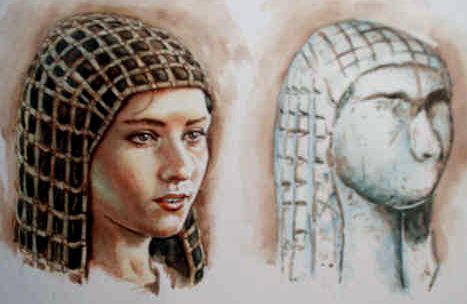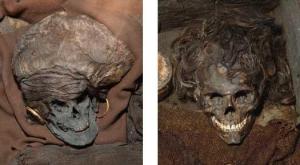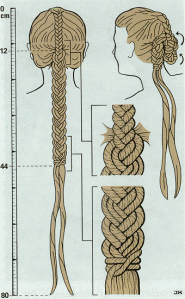Hair obviously does not survive very well in the archaeological record, usually, but there are exceptions. Bog bodies are one direct source of evidence, where hair and skin are preserved in the acidic tannin-rich environment of the peat. Beyond this, we have to look at representational art for more clues, although this often throws up more questions than it answers.
Palaeolithic
Representations of humans in Upper Palaeolithic cave art are very rare and usually partial or fantastical. Portable art tells another story, however, and there are a number of representations of both men and women, the latter famously called the Venus figurines, which will be looked at in more detail in another post. For now here are just a small number: the figurines known as the Venuses of Willendorf (Austria), Brassempouy (France) andone from Kostienki (Russia). All three have traces of some kind of hair-braiding or hair-covering. The Kostienki and Willendorf Venuses are very alike, despite being separated in time by 10,000 years and nearly 2000 miles. The authenticity of the Brassempouy Venus has been questioned. These images are from http://donsmaps.com/.
One artist’s reconstruction of the Brassempouy Venus’ head-covering is by Libor Balák.

Neolithic
The only hair surviving in the Neolithic comes from the famous Ötzi the Iceman who was found in the Italian Alps in 1991 after being preserved in ice for 5300 years. This had been shed from his body but some of it lay around him and showed he had shoulder-length brown hair that he wore loose (Spindler 1993, 161-2).
Bronze Age

Some hairstyles from the Bronze Age have been preserved in the peat bogs of Denmark. The most famous of these is the young man of Borum Eshøj, who died at around 20 years old. His hair is described as in the page-boy style, presumably a bob with a fringe. It is voluminous and slightly curly. The oak for his coffin was felled in 1350 BC.

The Skrydstrup woman, though only around 18 years of age, dates to around 1300 BC and had an elaborate hairdo, with the hair pulled forward over a pad (possibly made of her own hair), then tied round the head with thread plaited into the hair. This was then covered in a hairnet made from horse hair. The National Museum of Denmark has created a handy do-it-yourself guide (left).
The Egtved girl, who was buried around 1370 BC (and will feature in a post of her own) was only 16 or 17 years of age and had loose shoulder-length fair hair.
Iron Age
We turn to Denmark again for evidence of preserved hair, this time not from bodies laid out serenely in the grave but from bodied that have been sacrificed or executed and placed in bogs.
While Tollund Man, the most famous of the bog bodies from Denmark and dating to about 300 BC, had short cropped hair, this may not have been typical. Windeby girl’s (from c. AD 100) hair had been deliberately shaved on one side and cropped short on the other presumably as part of her sacrifice or punishment (Aldhouse-Green 2004, 303).
Osterby Man died in the 1st century AD as well and had what has become known as a Suebian knot, which involves twsiting two plaits together on the side of the head and is an arrangement seen on images of barbarians carved on Trajan’s Column (Aldhouse-Green 2004, 302).

Elling Woman died around 280 BC, around the same time as Tollund Man and only 60m away, and had an elaborate plaited hairdo. Here is a diagram to show how the hair was braided on the right. Start by making a regular pigtail with the hair from the top of the head. At the hairline on the back of the neck you divide the hair into seven parts and braid these together two, two and three. The pigtail is divided into three and plaited regularly, and then the other three plaits are plaited together when they join. The ends of the hair are left in two twisted pigtails. Her hair was knotted up on the day she died but if it was left down it would have been about a metre long.
More hairstyles will be added to this post as research continues.
References
Aldhouse-Green, M 2004. Crowning Glories: languages of hair in later prehistoric Europe. Proceedings of the Prehistoric Society 70, pp 299-325.
Glob, P. V, 1970. The Mound People. London, Faber & Faber.
Spindler, K 1993. The Man in the Ice. London, Weidenfeld & Nicholson.




Very puzzled I didn’t know of this blog beforehand. Now I’ve got it all to trawl through – *happy sigh*
LikeLiked by 1 person
Hello and welcome! There’s not much on here yet but planning to keep writing when I have time to do research. Kim
LikeLiked by 1 person